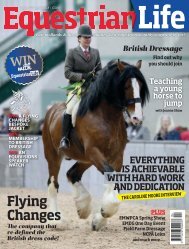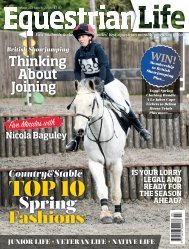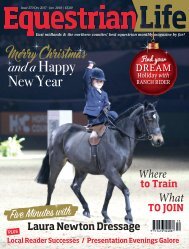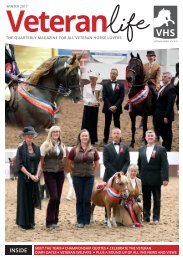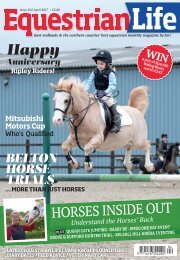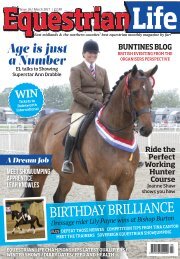Equestrian Life May 2018 Issue
You also want an ePaper? Increase the reach of your titles
YUMPU automatically turns print PDFs into web optimized ePapers that Google loves.
dressage<br />
ANYONE CAN<br />
GET A SUB<br />
30<br />
dressage score!<br />
WORDS BY TINA CANTON BHSI BSC (HONS) UKCC LEVEL 3<br />
Yes, this is a bold statement,<br />
but I truly believe that with a<br />
bit of focus and effort even an<br />
ordinary moving horse, with an<br />
average rider can present a test that the<br />
judge just has to give good marks to! I<br />
often see people throwing marks away<br />
with things that are a very simple fix. So,<br />
by following the few suggestions below,<br />
let’s see if we can put a smile on the<br />
judges’ face, and yours when you go to<br />
the scoreboard!<br />
UNDERSTAND THE<br />
1 GERMAN SCALES OF<br />
TRAINING<br />
• Rhythm;<br />
• Suppleness;<br />
• Contact;<br />
• Impulsion;<br />
• Straightness;<br />
• and, eventually,<br />
Collection<br />
This is what all judges base their marks<br />
on. If you fulfil them - it is very hard for<br />
them to justify a bad mark!<br />
The most important one at lower levels<br />
is RHYTHM. No matter what level the<br />
horse is at this is key! I often see horses<br />
being rushed out of their natural rhythm.<br />
Try to get yourself videoed riding a test<br />
or even schooling at home. You will be<br />
amazed how rushed it often looks. Try<br />
slowing it down a bit in schooling. It<br />
may take a while for the horse to learn<br />
to balance and stay in front of your aids<br />
but, it will make test riding easier as it<br />
will buy you some time to think. It also<br />
allows you to prepare movements better.<br />
Often people rush as they confuse speed<br />
with impulsion - they are totally different<br />
creatures!<br />
TRY TO MAINTAIN A<br />
2 CONSISTENT OUTLINE<br />
Number 3 on the scales of training is<br />
contact. This is only as good as your<br />
hands! Remember both ends of the<br />
rein counts. If your horse is difficult or<br />
resistive in the contact it may be time<br />
to go back to basics. Obviously check all<br />
the obvious thing such as dental care,<br />
saddle fitting, lameness, injuries etc. At<br />
home we often go back to working horses<br />
from the ground - specifically lunging, to<br />
re-educate them to soften to the pressure<br />
of a contact. Avoid at all costs see-sawing<br />
at a horse’s mouth. All this does is annoy<br />
them and create a wobbly nose and a<br />
sore mouth. It is always worth looking at<br />
your horse’s mouth conformation. Often<br />
horses with a big tongue work better in a<br />
ported bit - but this would not be suitable<br />
for a horse with a low palate. There are<br />
bitting clinics available for specialist help<br />
- or ask your trainers advice.<br />
TRY TO BE AS ACCURATE<br />
3 IN YOUR MOVEMENTS AS<br />
YOU CAN<br />
How many times have we all missed a<br />
38 <strong>May</strong> <strong>2018</strong> <strong>Equestrian</strong> <strong>Life</strong>



